The global anti-caking agents market is valued at USD 866.7 million in 2025 and is poised to reach USD 1,371.2 million by 2035, which shows a CAGR of 4.8%. Growth will be driven by the rising demand for processed and packaged foods, the expansion of the animal feed industry, and the growing use of anti-caking agents in fertilizers to improve flowability and prevent clumping.
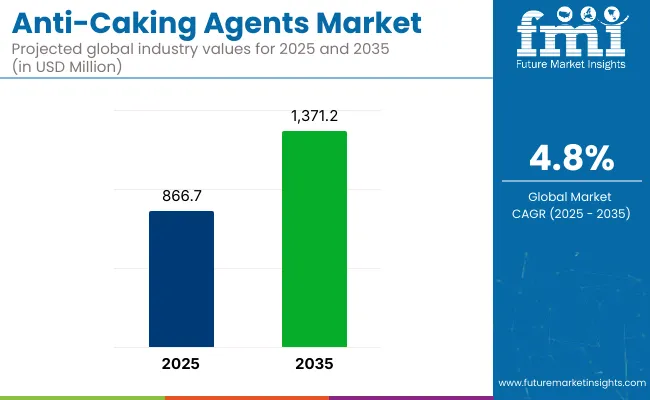
| Metric | Value |
|---|---|
| 2025 Market Size | USD 866.7 million |
| 2035 Market Size | USD 1,371.2 million |
| CAGR (2025 to 2035) | 4.8% |
Moreover, increasing health and wellness trends are boosting the preference for natural anti-caking agents, encouraging manufacturers to reformulate products with clean-label ingredients to meet consumer expectations.
Japan is projected to record the highest CAGR in the market at 5.2%, driven by rising demand for instant noodles and processed foods. Germany will follow with a CAGR of 3.5% due to strong fertilizer and dairy sectors, while the USA will grow at 3.2%, supported by high processed food consumption and fertilizer use.
Fertilizers will lead the application segment with a 35.2% share, and the synthetic source segment will dominate with a 52.6% share, driven by its cost-effectiveness, high functionality, and widespread use across food, feed, and industrial applications.
The market holds a relatively small but essential share within its parent markets. In the food additives segment, it accounts for around 3% due to its specific use in powdered products to maintain a free-flowing texture. Within feed additives, its share is approximately 4%, driven by the increasing demand for compound feed globally.
In fertilizer additives, it represents nearly 5% as it plays a critical role in preventing clumping and ensuring efficient application. Its share in functional food ingredients is about 2% because it indirectly supports product quality, while in industrial additives, it holds around 1% due to niche applications.
The market segments include source, product type, application, and region. The source segment covers natural and synthetic sources. The product type segment includes sodium compound, calcium compound, magnesium compound, silicon dioxide, microcrystalline cellulose, and other product types (such as phosphate compounds and tricalcium phosphate).
The application segment comprises food & beverages, animal feed, pharmaceuticals, fertilizers, and other applications (including cosmetics, personal care, and industrial chemicals). The regional segment includes North America, Latin America, Western Europe, Eastern Europe, Balkans & Baltic, Russia & Belarus, Central Asia, East Asia, South Asia & Pacific, and the Middle East & Africa.
The synthetic source segment is projected to hold a 52.6% market share in 2025.
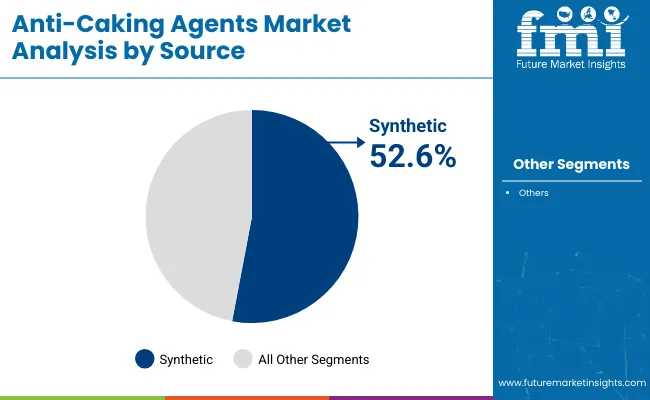
The sodium compound segment is projected to hold a market share of approximately 30% in 2025 within the market.
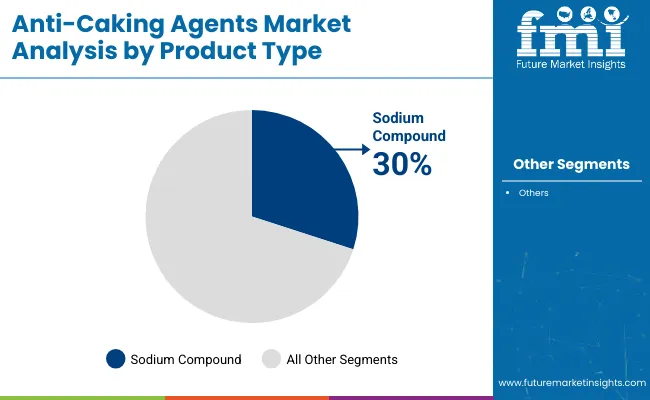
The fertilizer segment is expected to remain the most lucrative application segment in the market, holding a 35.2% market share in 2025.
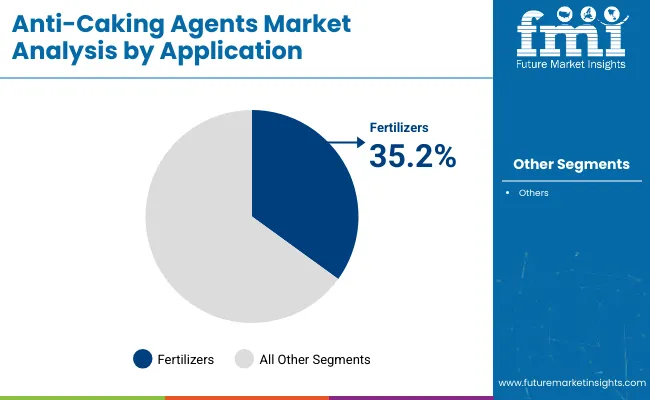
The global market is growing steadily, driven by rising demand for processed and packaged foods, increasing use in fertilizers to enhance product flowability, and advancements in natural and nano-sized anti-caking agent formulations across food, feed, and industrial applications.
Recent Trends in the Anti-caking Agents Market
Challenges in the Anti-caking Agents Market
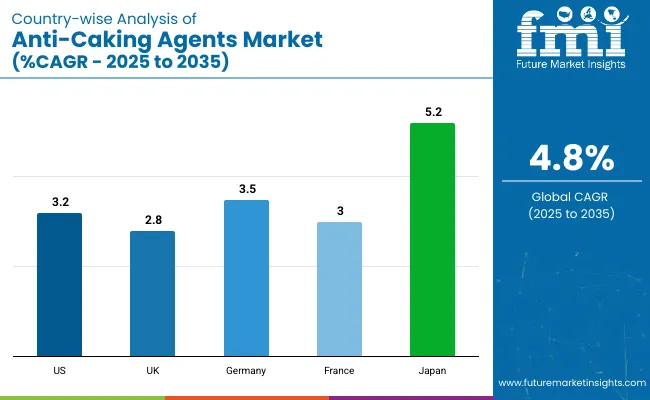
Among the top five countries, Japan is projected to witness the highest growth in the market with a CAGR of 5.2% during the forecast period, driven by rising demand for instant food mixes and technological advancements. Germany follows with a CAGR of 3.5%, supported by strong fertilizer and food industries.
The USA is expected to grow at 3.2% due to high processed food consumption, while France will see a moderate CAGR of 3.0%, backed by its robust bakery sector. The UK will register the slowest growth among these countries, with a steady CAGR of 2.8%.
The report covers an in-depth analysis of 40+ countries; five top-performing OECD countries are highlighted below.
The USA anti-caking agents market is projected to grow at a CAGR of 3.2% during the forecast period.
Sales of anti-caking agents in the UK are expected to register a steady CAGR of around 2.8% over 2025 to 2035.
Sales of anti-caking agents in Germany are projected to grow at a CAGR of 3.5% from 2025-2035.
France’s anti-caking agents revenue is expected to grow at a CAGR of 3.0% during the forecast period.
Japan’s anti-caking agent demand is projected to register a CAGR of 5.2% during the forecast period, driven by rapid growth in packaged food consumption, rising demand for instant food mixes, and advancements in food technology enhancing product efficiency and stability.
The market is moderately fragmented, featuring a mix of global leaders and regional players. Top-tier companies such as BASF SE, Solvay SA, Kao Group, Evonik Industries AG, and PPG Industries, Inc. dominate the market through extensive R&D investments, strategic partnerships, and product innovations.
For instance, BASF SE has streamlined its portfolio by divesting non-core businesses, while Solvay SA has invested in expanding its hydrogen peroxide production to meet growing demand. Kao Group has introduced nano-sized anti-caking particles, improving efficiency and aligning with clean-label trends. Evonik Industries AG has focused on sustainable silica production, and PPG Industries, Inc. has developed high-capacity carrying agents for bulk applications.
Recent Anti-caking Agents Industry News:
| Report Attributes | Details |
|---|---|
| Current Total Market Size (2025) | USD 866.7 million |
| Projected Market Size (2035) | USD 1,371.2 million |
| CAGR (2025 to 2035) | 4.8% |
| Base Year for Estimation | 2024 |
| Historical Period | 2020 to 2024 |
| Projections Period | 2025 to 2035 |
| Market Analysis Parameters | Revenue in USD million/Volume in kilotons |
| By Source | Natural Source, Synthetic Source |
| By Product Type | Sodium Compound, Calcium Compound, Magnesium Compound, Silicon Dioxide, Microcrystalline Cellulose, Other Product Types (Phosphate Compounds, Tricalcium Phosphate, Potassium Ferrocyanide, Sodium Ferrocyanide, Calcium Silicate, And Talc) |
| By Application | Food & Beverages, Animal Feed, Pharmaceuticals, Fertilizer, Other Applications (Cosmetics, Personal Care Products, And Industrial Chemicals) |
| Regions Covered | North America, Latin America, Western Europe, Eastern Europe, Balkans & Baltic, Russia & Belarus, Central Asia, East Asia, South Asia & Pacific, Middle East & Africa |
| Countries Covered | United States, Canada, United Kingdom, Germany, France, China, Japan, South Korea, Brazil, Australia |
| Key Players | BASF SE, Solvay SA, Kao Group, PPG Industries, Inc., ArrMaz, R. Grace & Co.-Conn., Evonik Industries AG, JELU-WERK J. Ehrler GmbH & Co. KG, Allied Blending LP, EP Minerals, Agropur Ingredients, PQ Corporation, Neelam Aqua & Speciality Chem. (P) Ltd., Dorf Ketal, Omya International AG, and NAQ |
| Additional Attributes | Dollar sales by value, market share analysis by region, and country-wise analysis |
As per Product Type, the industry has been categorized into Sodium Compound, Calcium Compound, Magnesium Compound, Silicon Dioxide, Microcrystalline cellulose, and Other Product Type.
As per Source, the industry has been categorized into Natural Source, and Synthetic Source.
This segment is further categorized into Food & Beverages, Pharmaceuticals, Animal Feed, Fertilizer, and Other Applications.
Industry analysis has been carried out in key countries of North America, Latin America, Western Europe, Eastern Europe, East Asia, South Asia & Pacific, Central Asia, Russia and Belarus, Balkan & Baltics, and the Middle East & Africa.
The market is valued at USD 866.7 million in 2025.
The market is projected to reach USD 1,371.2 million by 2035.
Japan is the fastest-growing country with a CAGR of 5.2%.
The fertilizer segment leads with a 35.2% market share in 2025.
The market is projected to grow at a CAGR of 4.8% during this period.






Our Research Products

The "Full Research Suite" delivers actionable market intel, deep dives on markets or technologies, so clients act faster, cut risk, and unlock growth.

The Leaderboard benchmarks and ranks top vendors, classifying them as Established Leaders, Leading Challengers, or Disruptors & Challengers.

Locates where complements amplify value and substitutes erode it, forecasting net impact by horizon

We deliver granular, decision-grade intel: market sizing, 5-year forecasts, pricing, adoption, usage, revenue, and operational KPIs—plus competitor tracking, regulation, and value chains—across 60 countries broadly.

Spot the shifts before they hit your P&L. We track inflection points, adoption curves, pricing moves, and ecosystem plays to show where demand is heading, why it is changing, and what to do next across high-growth markets and disruptive tech

Real-time reads of user behavior. We track shifting priorities, perceptions of today’s and next-gen services, and provider experience, then pace how fast tech moves from trial to adoption, blending buyer, consumer, and channel inputs with social signals (#WhySwitch, #UX).

Partner with our analyst team to build a custom report designed around your business priorities. From analysing market trends to assessing competitors or crafting bespoke datasets, we tailor insights to your needs.
Supplier Intelligence
Discovery & Profiling
Capacity & Footprint
Performance & Risk
Compliance & Governance
Commercial Readiness
Who Supplies Whom
Scorecards & Shortlists
Playbooks & Docs
Category Intelligence
Definition & Scope
Demand & Use Cases
Cost Drivers
Market Structure
Supply Chain Map
Trade & Policy
Operating Norms
Deliverables
Buyer Intelligence
Account Basics
Spend & Scope
Procurement Model
Vendor Requirements
Terms & Policies
Entry Strategy
Pain Points & Triggers
Outputs
Pricing Analysis
Benchmarks
Trends
Should-Cost
Indexation
Landed Cost
Commercial Terms
Deliverables
Brand Analysis
Positioning & Value Prop
Share & Presence
Customer Evidence
Go-to-Market
Digital & Reputation
Compliance & Trust
KPIs & Gaps
Outputs
Full Research Suite comprises of:
Market outlook & trends analysis
Interviews & case studies
Strategic recommendations
Vendor profiles & capabilities analysis
5-year forecasts
8 regions and 60+ country-level data splits
Market segment data splits
12 months of continuous data updates
DELIVERED AS:
PDF EXCEL ONLINE
Matting Agents Market Size and Share Forecast Outlook 2025 to 2035
Healing Agents Market (Skin Repair & Soothing Actives) Market Size and Share Forecast Outlook 2025 to 2035
Foaming Agents Market Size and Share Forecast Outlook 2025 to 2035
Firming Agents Botox-Like Market Size and Share Forecast Outlook 2025 to 2035
Heating Agents Market Size and Share Forecast Outlook 2025 to 2035
Cooling Agents Market Size and Share Forecast Outlook 2025 to 2035
Firming Agents Market Growth – Product Innovations & Applications from 2025 to 2035
Raising Agents Market Trends – Growth & Industry Forecast 2024 to 2034
Weighing Agents Market Size and Share Forecast Outlook 2025 to 2035
Draining Agents Market Size and Share Forecast Outlook 2025 to 2035
Flatting Agents Market Size and Share Forecast Outlook 2025 to 2035
Clouding Agents Market Trends - Growth Factors & Industry Analysis
Cognitive Agents Market Size and Share Forecast Outlook 2025 to 2035
Anti-Acne Agents Market Size and Share Forecast Outlook 2025 to 2035
Flavoring Agents Market Size and Share Forecast Outlook 2025 to 2035
Leavening Agents Market Analysis - Size, Growth, and Forecast 2025 to 2035
Market Share Breakdown of Anti-Slip Agents Manufacturers
Coalescing Agents Market Size and Share Forecast Outlook 2025 to 2035
Mattifying Agents Market Size and Share Forecast Outlook 2025 to 2035
Biocontrol Agents Market Size and Share Forecast Outlook 2025 to 2035

Thank you!
You will receive an email from our Business Development Manager. Please be sure to check your SPAM/JUNK folder too.
Chat With
MaRIA